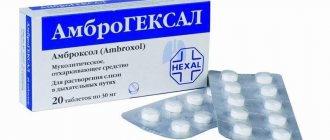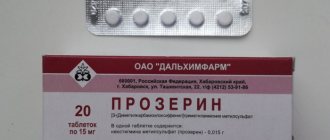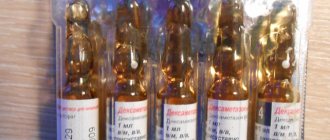Release form, composition and packaging
The solution for intravenous and intramuscular administration is transparent, colorless or with a yellowish tint.
| 1 ml | 1 amp. | |
| ketoprofen | 50 mg | 100 mg |
Excipients: propylene glycol - 800 mg, ethanol (ethyl alcohol 95% in terms of 100% substance) - 200 mg, benzyl alcohol - 40 mg, sodium hydroxide - up to pH 6.5-7.5, water for injection - up to 2 ml.
2 ml - dark glass ampoules (5) - contour cell packaging (1) - cardboard packs. 2 ml - dark glass ampoules (5) - contour cell packaging (2) - cardboard packs.
In addition we recommend:
- OKI, granules
- XEFOCAM RAPID, tablets
Price
The cost of the drug is determined by its dosage form and dosage.
Terms of sale in pharmacies
The drug is dispensed according to a doctor's prescription.
Price
| Release form | Amount in a package | Average price in Russia | Average cost in Ukraine |
| Pills | 20 tablets | 156-170 rub. | from 150 to 314 UAH. |
| Capsules | 25 capsules | — | 150 UAH |
Indications
For the symptomatic treatment of pain and inflammation of various origins of moderate intensity (does not affect the progression of the disease):
- inflammatory and degenerative diseases of the musculoskeletal system: rheumatoid, psoriatic, juvenile chronic arthritis, ankylosing spondylitis (Bechterew's disease), gouty arthritis, rheumatic lesions of soft tissues, osteoarthritis of peripheral joints and spine (including with radicular syndrome);
- lumbago, sciatica;
- neuralgia;
- migraine;
- algodismenorrhea;
- inflammatory processes of the pelvic organs, incl. adnexitis;
- post-traumatic pain syndrome accompanied by inflammation;
- postoperative pain;
- toothache;
- pain syndrome in cancer.
Contraindications
- erosive and ulcerative lesions of the gastrointestinal tract (in the acute phase);
- bleeding from the gastrointestinal tract, inflammatory bowel diseases in the acute phase (nonspecific ulcerative colitis, Crohn's disease);
- severe liver failure or liver disease in the acute period;
- severe renal failure (CK
- progressive kidney disease;
- hyperkalemia;
- complete or incomplete combination of bronchial asthma, recurrent polyposis of the nose and paranasal sinuses and intolerance to acetylsalicylic acid or other NSAIDs (including a history);
- impaired hematopoiesis, impaired hemostasis (including hemophilia);
- III trimester of pregnancy;
- lactation period;
- children under 15 years of age;
- period after coronary artery bypass surgery;
- hypersensitivity (including to other NSAIDs or auxiliary components).
The drug should be prescribed with caution for bronchial asthma; the presence of factors that increase gastrointestinal toxicity (alcoholism and cholecystitis); chronic heart failure; edema syndrome; arterial hypertension, renal dysfunction, cholestasis, sepsis, simultaneous use with other NSAIDs; IHD, cerebrovascular diseases; dyslipidemia/hyperlipidemia; diabetes mellitus; peripheral arterial diseases; chronic renal failure (creatinine clearance 30-60 ml/min); history of ulcerative lesions of the gastrointestinal tract; confirmed presence of Helicobacter pylori infection; long-term use of NSAIDs; severe somatic diseases; concomitant therapy with anticoagulants (including warfarin), antiplatelet agents (including acetylsalicylic acid, clopidogrel), selective serotonin reuptake inhibitors (including citalopram, fluoxetine, paroxetine, sertraline), corticosteroids (including including prednisolone); smoking; elderly patients (over 65 years old); in the first and second trimesters of pregnancy.
To reduce the risk of developing adverse events from the gastrointestinal tract, the minimum effective dose should be used for the shortest possible short course.
FLAMAX
Drug: FLAMAX Active substance: ketoprofen ATC code: M01AE03 KFG: NSAID Reg. number: LS-000429 Registration date: 12/04/08 Owner reg. credential: PharmFirma SOTEX (Russia)
DOSAGE FORM, COMPOSITION AND PACKAGING
Flamax
The solution for intramuscular administration is clear, colorless or slightly colored.
| 1 ml | 1 amp. | |
| ketoprofen | 50 mg | 100 mg |
Excipients: propylene glycol, ethanol, benzyl alcohol, sodium hydroxide (1M solution), water for injection.
2 ml - dark glass ampoules (5) - contour cell packaging (1) - cardboard packs. 2 ml - dark glass ampoules (5) - contour cell packaging (2) - cardboard packs. 2 ml - dark glass ampoules (5) - contour cell packaging (1) - cardboard packs. 2 ml - dark glass ampoules (5) - contour cell packaging (2) - cardboard packs.
Flamax®
The solution for intravenous and intramuscular administration is clear, colorless or slightly brownish.
| 1 ml | 1 amp. | |
| ketoprofen | 50 mg | 100 mg |
Excipients: propylene glycol - 800 mg, ethanol - 200 mg, benzyl alcohol - 40 mg, sodium hydroxide (pH 6.5-7.5), water for injection - up to 2 ml.
2 ml - dark glass ampoules (5) - contour cell packaging (1) - cardboard packs.
2 ml - dark glass ampoules (5) - contour cell packaging (2) - cardboard packs. INSTRUCTIONS FOR USE FOR SPECIALISTS.
The description of the drug was approved by the manufacturer in 2012. PHARMACOLOGICAL ACTION
Non-steroidal anti-inflammatory drug, propionic acid derivative. It has an analgesic, anti-inflammatory and antipyretic effect, suppresses platelet aggregation. By acting on the cyclooxygenase and lipoxygenase components of arachidolic acid metabolism, ketoprofen inhibits the synthesis of prostaglandins, leukotrienes and thromboxanes. The analgesic effect is due to both central and peripheral mechanisms.
PHARMACOKINETICS
Distribution
Up to 99% of ketoprofen is bound to plasma proteins, mainly albumin. Cmax is reached quickly due to the low volume of distribution (0.1-0.2 l/kg). The equilibrium concentration of ketoprofen is achieved 24 hours after the start of its regular use. Ketoprofen penetrates well into synovial fluid and connective tissue. A significant concentration in the synovial fluid is achieved within 15 minutes after a single intramuscular injection of 100 mg of ketoprofen. Although the concentrations of ketoprofen in synovial fluid are slightly lower than in plasma, they are more stable (lasting up to 30 hours), resulting in a long-term reduction in pain and joint stiffness. It does not penetrate the BBB in significant quantities.
Metabolism
Ketoprofen is mainly metabolized in the liver, where it undergoes glucuronidation to form esters with glucuronic acid, excreted mainly by the kidneys. Has a “first pass” effect through the liver.
Removal
It is excreted mainly by the kidneys. Excretion in feces is less than 1%. T1/2 of ketoprofen ranges from 1.6 to 1.9 hours. It does not accumulate.
INDICATIONS
For the symptomatic treatment of pain and inflammation of various origins of moderate intensity:
- inflammatory and degenerative diseases of the musculoskeletal system: rheumatoid, psoriatic, juvenile chronic arthritis, ankylosing spondylitis (ankylosing spondylitis), gouty arthritis, rheumatic lesions of soft tissues, osteoarthritis of peripheral joints and the spine (including with radicular syndrome);
- lumbago, sciatica, neuralgia, migraine;
- algodismenorrhea, inflammatory processes of the pelvic organs, incl. adnexitis;
- post-traumatic pain syndrome accompanied by inflammation;
- postoperative pain;
- toothache;
— pain syndrome in oncological diseases (does not affect the progression of the disease).
DOSING REGIME
IV, IM.
IM administration: 100 mg (1 ampoule) 1-2 times a day. Intravenous infusion of the drug should be carried out only in a hospital setting. The average infusion time is 0.5-1 hour, the maximum is no more than 48 hours, and the dose of the drug should not exceed 300 mg. Short intravenous infusion: 100-200 mg (1-2 ampoules) of the drug, diluted in 100 ml of 0.9% sodium chloride solution, is administered over 0.5-1 hour. Repeated administration is possible after 8 hours.
Long-term intravenous infusion: 100-200 mg (1-2 ampoules) of the drug diluted in 500 ml of solution for infusion (0.9% sodium chloride solution, Ringer's solution, 5% dextrose solution) for 8 hours. Repeated administration is possible after 8 hours.
Combined use
Flamax® can be combined with centrally acting analgesics; it can be mixed with morphine in one vial. Do not mix in the same bottle with tramadol due to sedimentation.
Parenteral administration of Flamax® can be combined with the use of oral forms (tablets, capsules) or rectal suppositories, and the total daily dose can be increased to 300 mg or reduced to 100 mg, depending on the nature of the disease and the patient’s condition.
The minimum effective dose should be used for the shortest possible course (see section "Special Instructions").
SIDE EFFECT
From the digestive system: abdominal pain, dyspepsia (nausea, vomiting, heartburn, flatulence, loss of appetite, diarrhea), stomatitis, impaired liver function, change in taste. With long-term use in large doses - ulceration of the mucous membrane of the gastrointestinal tract, gingival, gastrointestinal, and hemorrhoidal bleeding.
From the nervous system: headache, dizziness, insomnia, agitation, nervousness, drowsiness, depression, asthenia, confusion or loss of consciousness, memory impairment, migraine, peripheral neuropathy.
From the senses: noise or ringing in the ears, blurred vision, conjunctivitis, dry mucous membrane of the eye, pain in the eyes, conjunctival hyperemia, hearing loss, vertigo.
From the cardiovascular system: increased blood pressure, tachycardia.
From the hematopoietic organs: agranulocytosis, anemia, hemolytic anemia, thrombocytopenia, leukopenia.
From the urinary system: edema syndrome, cystitis, urethritis, renal dysfunction, interstitial nephritis, nephrotic syndrome, hematuria.
Allergic reactions: skin rash (including erythematous, urticaria), skin itching, rhinitis, angioedema, bronchospasm, exfoliative dermatitis, anaphylactic shock.
Other: increased sweating, hemoptysis, nosebleeds, myalgia, muscle twitching, shortness of breath, thirst, photosensitivity, with long-term use in large doses - vaginal bleeding.
CONTRAINDICATIONS
- hypersensitivity (including to other non-steroidal anti-inflammatory drugs or auxiliary components);
- erosive and ulcerative lesions of the gastrointestinal tract (in the acute phase);
- bleeding from the gastrointestinal tract, inflammatory bowel diseases in the acute phase (nonspecific ulcerative colitis, Crohn's disease);
- severe liver failure or liver disease in the acute period;
- severe renal failure (creatinine clearance (CC) less than 30 ml/min);
- progressive kidney diseases;
- hyperkalemia;
- complete or incomplete combination of bronchial asthma, recurrent polyposis of the nose and paranasal sinuses and intolerance to acetylsalicylic acid or other NSAIDs (including a history);
- impaired hematopoiesis, impaired hemostasis (including hemophilia);
— pregnancy (III trimester);
- lactation period;
- children's age (up to 15 years);
— the period after coronary artery bypass grafting.
With caution: bronchial asthma, the presence of factors that increase gastrointestinal toxicity: alcoholism and cholecystitis, chronic heart failure, edema syndrome; arterial hypertension, renal dysfunction, cholestasis, sepsis, simultaneous use with other NSAIDs, old age (over 65 years), pregnancy (I-II trimester).
Coronary heart disease, cerebrovascular diseases, dyslipidemia/hyperlipidemia, diabetes mellitus, peripheral arterial disease, smoking, chronic renal failure (creatinine clearance 30-60 ml/min).
Anamnestic data on the development of ulcerative lesions of the gastrointestinal tract, confirmed presence of Helicobacter pylori infection, long-term use of NSAIDs, severe somatic diseases, concomitant therapy with the following drugs:
- anticoagulants (including warfarin);
- antiplatelet agents (including acetylsalicylic acid, clopidogrel);
- selective serotonin reuptake inhibitors (including citalopram, fluoxetine, paroxetine, sertraline);
- glucocorticosteroids (including prednisolone).
To reduce the risk of developing adverse events from the gastrointestinal tract, the minimum effective dose should be used for the shortest possible short course.
PREGNANCY AND LACTATION
The use of Flamax® in the third trimester of pregnancy and during breastfeeding is contraindicated (feeding should be avoided while using the drug).
Use in the first and second trimesters of pregnancy is allowed if the potential benefit to the mother outweighs the potential risk to the fetus.
SPECIAL INSTRUCTIONS
When using Flamax® and warfarin or lithium drugs simultaneously, patients should be under strict medical supervision. Caution must be exercised when prescribing the drug to patients with a history of peptic ulcers of the gastrointestinal tract, renal or liver failure, and those receiving coumarin anticoagulants. Like other drugs in this group, it can mask the symptoms of infectious diseases.
During treatment, monitoring of the peripheral blood picture and the functional state of the liver and kidneys is necessary.
If it is necessary to determine 17-ketosteroids, the drug should be discontinued 48 hours before the study.
If liver or kidney function is impaired, dose reduction and careful monitoring are necessary.
To reduce the risk of developing adverse events from the gastrointestinal tract, the minimum effective dose should be used in the shortest possible short course (see section “Dosage and Administration”).
Impact on the ability to drive vehicles and operate machinery
During the treatment period, care must be taken when driving vehicles and engaging in other potentially hazardous activities that require increased concentration and speed of psychomotor reactions.
OVERDOSE
Cases of overdose have not been described.
Symptoms: dizziness, vomiting, headache, shortness of breath, abdominal pain, bleeding, liver and kidney dysfunction may occur.
Treatment: symptomatic.
DRUG INTERACTIONS
With the simultaneous use of Flamax® and loop diuretics, the nephrotoxic effect of both drugs is enhanced. Reduces the effectiveness of uricosuric drugs, enhances the effect of anticoagulants, antiplatelet agents, fibrinolytics, ethanol, side effects of glucocorticosteroids and mineralocorticosteroids, estrogens; reduces the effectiveness of antihypertensive drugs and diuretics.
Concomitant use with other NSAIDs, glucocorticosteroids, ethanol, corticotropin can lead to the formation of ulcers and the development of gastrointestinal bleeding, increasing the risk of developing renal dysfunction. Concomitant use with oral anticoagulants, heparin, thrombolytics, antiplatelet agents, cefaperazone, cefamandole and cefotetan increases the risk of bleeding.
Increases the hypoglycemic effect of insulin and oral hypoglycemic drugs (dose recalculation is necessary). Inducers of microsomal oxidation in the liver (phenytoin, ethanol, barbiturates, rifampicin, phenylbutazone, tricyclic antidepressants) increase the production of hydroxylated active metabolites.
Combined use with sodium valproate leads to a decrease in platelet aggregation.
Increases plasma concentrations of verapamil and nifedipine, lithium preparations, methotrexate.
Antacids and cholestyramine reduce absorption.
Increases the hematotoxicity of myelotoxic drugs.
To avoid sediment, do not mix Flamax® and tramadol in one bottle.
CONDITIONS OF VACATION FROM PHARMACIES
On prescription.
CONDITIONS AND DURATION OF STORAGE
Store out of the reach of children at a temperature not exceeding 25 °C.
Shelf life: 4 years. Do not use after the expiration date stated on the packaging.
Dosage
The drug is intended for intravenous and intramuscular administration.
IM administration: 100 mg (1 ampoule) 1-2 times/day.
IV infusion of the drug should be carried out only in a hospital setting. The average infusion time is 0.5-1 hour, the maximum is no more than 48 hours, and the dose of the drug should not exceed 300 mg.
Short intravenous infusion: 100-200 mg (1-2 ampoules) of the drug, diluted in 100 ml of 0.9% sodium chloride solution, is administered over 0.5-1 hour. Repeated administration is possible after 8 hours.
Long-term intravenous infusion: 100-200 mg (1-2 ampoules) of the drug diluted in 500 ml of solution for infusion (0.9% sodium chloride solution, Ringer's solution, 5% dextrose solution) over 8 hours. Repeated administration is possible after 8 h.
The minimum effective dose should be used for the shortest possible short course.
Pharmacokinetics
Absorption is fast, bioavailability is 90%. Up to 99% of absorbed ketoprofen is bound to plasma proteins, mainly albumin. Cmax in plasma is achieved quickly (0.5–2 hours after oral administration) due to the low Vd (0.1–0.2 l/kg). Css of ketoprofen in plasma is achieved 24 hours after the start of its regular administration. Ketoprofen penetrates well into synovial fluid and connective tissue. Cmax in synovial fluid is 30% of the serum concentration, and 4–6 hours after administration it exceeds it. Ketoprofen penetrates the BBB. It is almost completely metabolized in the liver by glucuronidation and has a first-pass effect through the liver. Excreted by the kidneys (mainly) and intestines (1–8%). T1/2 - 1.6–1.9 hours. In the elderly, T1/2 increases to 3–5 hours, in patients with renal failure (Cl creatinine 20–60 ml/min) is about 3.5 hours. Does not accumulate.
Drug interactions
Flamax can be combined with centrally acting analgesics; can be mixed with morphine in one vial. It should not be mixed in the same vial with tramadol due to sedimentation.
Parenteral administration of the drug Flamax can be combined with the use of oral forms (tablets, capsules) or rectal suppositories, and the total daily dose can be increased to 300 mg or reduced to 100 mg, depending on the nature of the disease and the patient’s condition.
With the simultaneous use of Flamax and loop diuretics, the nephrotoxic effect of both drugs is enhanced.
Ketoprofen reduces the effectiveness of uricosuric drugs.
Enhances the effect of anticoagulants, antiplatelet agents, fibrinolytics, ethanol, side effects of glucocorticosteroids and mineralocorticosteroids, estrogens; reduces the effectiveness of antihypertensive drugs and diuretics.
Simultaneous use with other NSAIDs, corticosteroids, ethanol, corticotropin can lead to the formation of ulcers and the development of gastrointestinal bleeding, increasing the risk of developing renal dysfunction.
Concomitant use with oral anticoagulants, heparin, thrombolytics, antiplatelet agents, cefoperazone, cefamandole and cefotetan increases the risk of bleeding.
Ketoprofen enhances the hypoglycemic effect of insulin and oral hypoglycemic drugs (dose recalculation is necessary).
Inducers of microsomal oxidation enzymes in the liver (phenytoin, ethanol, barbiturates, rifampicin, phenylbutazone, tricyclic antidepressants) increase the production of hydroxylated active metabolites.
Simultaneous use with sodium valproate leads to a decrease in platelet aggregation.
Ketoprofen increases the plasma concentration of verapamil and nifedipine, lithium preparations, methotrexate.
Antacids and cholestyramine reduce the absorption of ketoprofen.
Myelotoxic drugs increase the manifestations of hematotoxicity of the drug.
Side effects
From the digestive system: abdominal pain, dyspepsia (nausea, vomiting, heartburn, flatulence, loss of appetite, diarrhea), stomatitis, impaired liver function, change in taste. With long-term use in large doses - ulceration of the gastrointestinal mucosa, gingival, gastrointestinal, and hemorrhoidal bleeding.
From the nervous system: headache, dizziness, insomnia, agitation, nervousness, drowsiness, depression, asthenia, confusion or loss of consciousness, memory impairment, migraine, peripheral neuropathy.
From the senses: noise or ringing in the ears, blurred vision, conjunctivitis, dry mucous membrane of the eye, pain in the eyes, conjunctival hyperemia, hearing loss, vertigo.
From the cardiovascular system: increased blood pressure, tachycardia.
From the hematopoietic system: agranulocytosis, anemia, hemolytic anemia, thrombocytopenia, leukopenia.
From the urinary system: edema syndrome, cystitis, urethritis, renal dysfunction, interstitial nephritis, nephrotic syndrome, hematuria.
Allergic reactions: skin rash (including erythematous, urticaria), skin itching, rhinitis, angioedema, bronchospasm, exfoliative dermatitis, anaphylactic shock.
Other: increased sweating, hemoptysis, nosebleeds, myalgia, muscle twitching, shortness of breath, thirst, photosensitivity, with long-term use in large doses - vaginal bleeding.
If any of the above side effects develop, as well as if other side effects not listed in the instructions occur, the patient should inform the doctor.
Customer Reviews
Kira. I took the drug after a major operation. I was able to get out of bed within an hour. One injection reduced the pain. Although the price of Flamax is high, the quality is also high. The composition is clear, no unnecessary chemicals.
Martha. I was interested in an analogue of Flamax, I thought it would cost less. I also looked for the drug in the form of suppositories, but did not find it. Apparently, you will have to give painful injections. I used to take pills before, but my body has already gotten used to it and the effect is no longer felt.
Yana. When I have headaches, I always take pills, the results appear immediately, they are an effective remedy. There were never any side effects. Perhaps because I did not combine the medicine with other active-spectrum drugs.
© 2020 – 2020, Evgeniy Nikolaevich Konoplev. All rights reserved.
special instructions
When using the drug Flamax and warfarin or lithium drugs simultaneously, patients should be under strict medical supervision.
Caution must be exercised when prescribing the drug to patients with a history of gastrointestinal ulcers, renal or liver failure, and those receiving coumarin anticoagulants.
Like other drugs in this group, it can mask the symptoms of infectious diseases.
During treatment, monitoring of the peripheral blood picture and the functional state of the liver and kidneys is necessary.
If it is necessary to determine 17-ketosteroids, the drug should be discontinued 48 hours before the study.
If liver or kidney function is impaired, dose reduction and careful monitoring are necessary.
To reduce the risk of developing adverse events from the gastrointestinal tract, the minimum effective dose should be used for the shortest possible short course.
Impact on the ability to drive vehicles and operate machinery
During the treatment period, care must be taken when driving vehicles and engaging in other potentially hazardous activities that require increased concentration and speed of psychomotor reactions.







